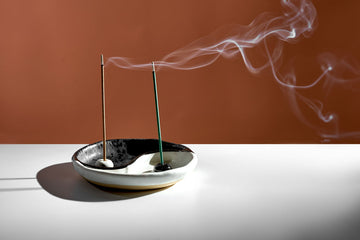In homes around the world, people reach for calming scents when they want to relax. In the West, that often means lighting a candle. In Asia—particularly in China—it usually means burning incense. At first glance, they might seem similar. Both release aroma, both create atmosphere. But beneath the surface, they come from very different traditions, and they offer very different experiences.
So how do they actually compare?

🧾 Quick Comparison: Chinese Incense vs. Western Candles
| Feature | Chinese Incense | Western Scented Candles |
|---|---|---|
| Cultural Origin | Rituals, meditation, healing | Interior décor, mood enhancement |
| Main Materials | Herbs, woods, resins, natural oils | Paraffin or soy wax, fragrance oils |
| Usage Context | Spiritual focus, mental clarity, sleep aid | Cozy ambience, seasonal decoration |
| Burning Experience | Rising smoke, steady aroma | Open flame, wax pool scent |
| Sensory Focus | Scent and atmosphere with symbolic meaning | Visual warmth and strong fragrance |
| Health Impact | Natural ingredients, low irritants | May contain artificial chemicals |
Tradition vs. Trend: A Cultural Gap
Chinese incense traces back thousands of years. It was used in temples, homes, and medicine—an everyday part of life. Lighting incense wasn’t only about the smell. It was a moment to pause, to think, to honor a time of focus.
Western candles, especially scented ones, are relatively recent. They’re popular because of how they look and smell. A warm glow on a dinner table, a cozy scent in the living room—candles speak to comfort and interior design. There's usually no ritual or intention beyond the fragrance itself.
👉 Choose incense if you’re drawn to meaningful routines and stillness.
👉 Choose candles if you enjoy visual warmth and decorative style.
Different Goals, Different Benefits
Chinese incense is often used to prepare the mind: for meditation, for study, or for winding down before bed. It encourages stillness, not stimulation. Its fragrances tend to be grounding—woody, herbal, even slightly bitter at times—meant to draw attention inward.
Candles aim for mood-lifting or cozy effects. Scents like vanilla, lavender, or berry are common. They invite people to feel relaxed, perhaps nostalgic. But they don't typically shift the mental state the way incense is meant to.
👉 Choose incense when you want to clear the mind or deepen focus.
👉 Choose candles when you want to make a space feel pleasant or familiar.
What They're Made Of
Traditional Chinese incense is usually made with ground herbs, roots, and tree resins. Common ingredients include agarwood, sandalwood, mugwort, clove, and ambergris. These are chosen not just for aroma but for their effects on the body and mind—helping to ease stress, encourage sleep, or improve attention.
Scented candles, on the other hand, are mostly made from paraffin or soy wax, combined with fragrance oils. Many of these oils are synthetic, designed to smell like perfumes or fruits.
👉 Choose incense if you're looking for natural, plant-based aromas.
👉 Choose candles if you prefer sweet or modern-style scents.
The Way They Burn
Incense releases fragrance through smoke. It’s usually lit once, and burns gently for 30–60 minutes. The scent builds slowly, and often lingers after the incense is gone.
Candles burn with a visible flame, melting wax to release their scent. The effect is immediate and more intense. But the fragrance tends to stay only as long as the candle burns.
👉 Choose incense for a calm, unfolding experience.
👉 Choose candles for instant impact.
Mental & Emotional Effects
Chinese incense is often used as a tool to shift energy—something closely tied to breathing and intention. Many users report feeling more centered, grounded, or restful after burning incense.
Some also use it for mindfulness practice, to mark the beginning of a quiet time. Certain types, like mugwort or sandalwood, are even said to support better sleep or deeper concentration.
Candles mostly enhance mood or decor. While a favorite candle scent may be comforting, it’s rarely used with the same level of intentional focus.
👉 Choose incense to support routines like journaling, meditation, or winding down.
👉 Choose candles when setting the mood for a room or event.
💭 Final Thoughts
Chinese incense and Western candles serve different emotional needs. While candles add visual warmth and fragrance, Chinese incense offers depth, intention, and tranquility that connects both mind and body.
If you're looking to improve your mindfulness practice, prepare for sleep, or simply try something more natural and cultural, Chinese incense is a meaningful alternative. Moramist offers carefully curated options that blend tradition with modern wellness—perfect for curious first-timers and seasoned aroma lovers alike.





